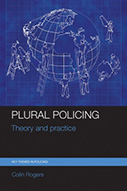Plural Policing: Theory and Practice

Author: Colin Rogers
Publisher: Bristol, UK; Chicago: University of Chicago Press: Policy Press, 2017. 184p.
Reviewer: Frank Leishman | July 2017
I found myself reviewing this book shortly after the suicide bombing at the Manchester Arena, and the subsequent vehicle and stabbing attacks on London Bridge. Coming as they did, just a few days before the UK General Election on 8 June 2017, concerns about policing and, in particular, around the numbers of public police officers employed emerged as a prominent party political issue in the final run-up to that voting. It was therefore timely to reflect on the changing policing landscape in England and Wales as explained in this useful volume by Colin Rogers, a former police inspector, and now Professor of Police Sciences at the University of South Wales.
The book is divided into three sections. Part 1 focuses on theory and principles underpinning plural policing, rehearsing familiar criminological arguments around the distinction between the ‘police’ and ‘policing’, drawing attention to the patchwork of policing provision that exists in England and Wales and other European jurisdictions. The discussion around information and intelligence sharing in the “new pluralised world of policing” has a strong contemporary resonance, emphasising, as it does, the challenges of ensuring democratic accountability in respect of its gathering, storage and management.
Part 2 considers public plural policing in England and Wales, with dedicated chapters on neighbourhood policing teams, police community support officers (PCSOs), and the rise of volunteer policing, which directs attention to the substantial costs associated with policing, and the ways in which individual police forces have adapted to an environment in which, as a former UK Police Minister stated, there would no longer be a “magic chequebook”. Rogers succinctly captures the rise of public-private partnerships (PPPs), which have seen the emergence of private companies such as G4S playing a more prominent role in policing alongside the public police.
The author suggests that the rise of ‘asset-based community development’ (ABCD) as a framework for community mobilisation in tackling local crime and anti-social behaviour problems, has links with the contested concept of the ‘Big Society’, famously promoted by the former British Prime Minister, David Cameron.
The final chapter considers future directions, including the inexorable development of direct entry to the public police service in the UK, which has traditionally relied on a two-year uniformed beat officer apprenticeship for all new recruits. In an age characterised by much greater complexity in policing and, in the face of transnational challenges such as terrorism and cyber-security, this approach is simply no longer tenable and, as Rogers argues, the shift towards direct entry demonstrates “a drive for a new form of professionalism” in policing.
In summary, this is a topical and informative volume, one of a number in a series Key Themes in Policing, which aims to reflect the importance of incorporating evidence- based policing into higher education curricula. It certainly functions as being helpful in navigating a route through the current plural policing landscape of England and Wales.
Professor Frank Leishman, Newman University, UK.


